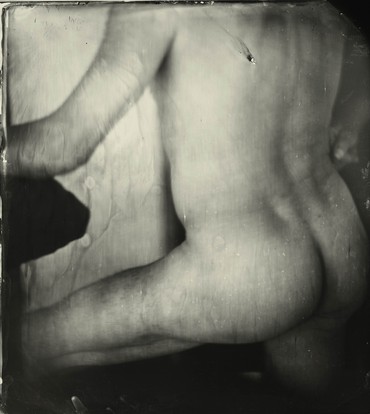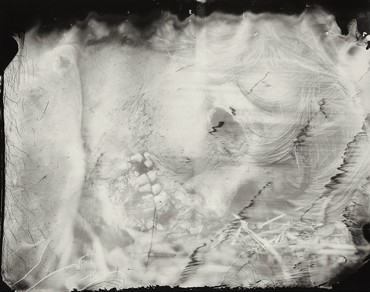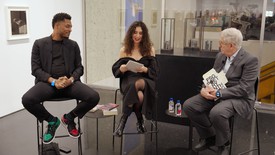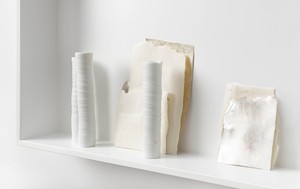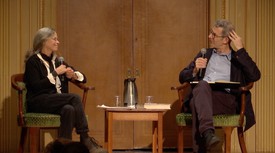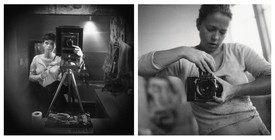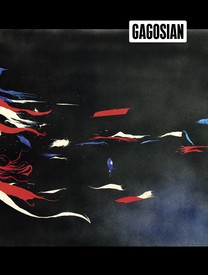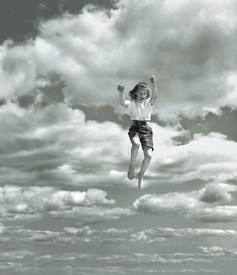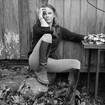
Sally Mann is an American photographer and writer. Her work is held in many notable collections, including the National Gallery of Art, Washington, DC; the Metropolitan Museum of Art, New York; the Victoria & Albert Museum, London; and the Moderna Museet, Stockholm. Mann’s Hold Still: A Memoir with Photographs (Little, Brown, 2015) was named a finalist for the 2015 National Book Awards and in 2016 won the Andrew Carnegie Medal for Excellence in Nonfiction. She was inducted into the American Academy of Arts and Sciences in 2022 and is a Prix Pictect laureate. Photo: Annie Leibovitz

Benjamin Moser is a writer based in the Netherlands. He is the author of Why This World: A Biography of Clarice Lispector (2009) and of Sontag: Her Life and Work (2020), for which he won a Pulitzer Prize. His new book, The Upside-Down World: Meetings with the Dutch Masters, was published in October 2023.
Sally MannY’all want to hear about our insomnia? [laughter]
Benjamin MoserWe were talking about insomnia and traveling and jetlag. I have the solution. You didn’t think you were coming here to hear this, but in France you can go to any pharmacy and get for €3 the best sleeping pills in the world. This has been a big moment in my life [laughter]. But we’re not here to talk about insomnia.
SMNot necessarily, but maybe it’s a symptom, or cause, of what we are coming to talk about, right?
BMDo you think it’s an artist’s affliction? It struck me pretty full on, actually, when I was writing this book.
SMWell no wonder. It’s an 832-page book.
BMAnd that’s volume 1.
SMHow is it that it took you—and I didn’t mean to ask this question, but now that we’re sort of talking about the body—how did it take you 270 pages to reveal that Susan Sontag had never had an orgasm?
BMOh. Well, that’s a great question. I didn’t know this because I’m a man [laughter], you know, and I’m gay. What I’m trying to say is, I don’t—I mean, I’m not going to break down the fourth wall here—but I don’t have sex with women [laughter]. I didn’t know about this. But Sontag was born in 1933, and when I started talking about this with a friend of mine who’s a feminist critic in the Netherlands, she said I should have written more about the orgasm.
SMI agree with your feminist friend.
BMSo I thought, “What’s there to write about?” Honestly, it never occurred to me that it was such a big deal. But she said, “In our generation it was the biggest event of our lives. In every feminist memoir, every memoir of a woman becoming a woman, this is a huge moment.”
SMIt’s true. I was reading along and I said out loud, “What?!” Because you’d written that she kept a list of all forty-six people she’d slept with.
BMBy the time she was eighteen.
SMShe’s had sex with over 100 people by the time she has her first orgasm. I think that merited more than just one offhand remark!
BMSontag says that she only really becomes a writer once she has orgasms.
SMYou differentiate between the orgasm she has with a man and then, years later, her first orgasm with a woman—and that, again, after she’s had 100 woman partners.
BMYou know what she says when she finally has an orgasm with a man? This is my favorite line in the book.
SMSee, I’m selling your book!
BMYou sure are. She collapses onto the pillow and says, “Oh, shit, now I’m just like everybody else” [laughter].
SMThat’s a great line.
BMActually, that part I did understand. I think when you’re gay, and when you become able to be happy and comfortable with that, the idea of heterosexuality—which when you’re twelve seems so great and enviable because you don’t get beaten up on the playground or whatever—once you get over that and you become a grownup, homosexuality becomes so essential to who you are. It’s something you’ve fought for. So I can imagine that to have an orgasm with a man might have felt a bit like a betrayal of that self she had fought for. Still, what was really interesting and sad for me about Sontag was that even though she did know that she was gay and she did have all these affairs, she never really became comfortable with that. It was always a source of shame and tension.
SMIt was a generational thing.
BMAlthough not only. Gayness, even with younger people, often remains fraught. And I didn’t know that because I didn’t have that experience. I don’t have a sad story about being gay. I didn’t realize how anomalous I was.
SMEven coming from the South you didn’t?
BMI came from Houston. My parents were Democrats. They were part of a progressive minority. In contrast, Sontag was living in the liberal hub of New York. And people would say, “You live on 24th Street and you’re this famous intellectual. Everybody knows you’re gay. Who cares? What’s the big deal? Not one person you’d ever meet anywhere would have a problem with this.” And yet she still had that shame.
As a biographer, I encountered a couple of things like that that I had to struggle to contextualize in different times. One was the attitude toward communist beliefs. I grew up, again, in a left-wing household in which everybody was very progressive. But I didn’t know anyone who was interested in communism in Houston.
SMI was sent to a left-leaning boarding school, Putney, Vermont, founded by a woman whose children lived for decades in China both before and after the revolution.
BMReally?
SMYeah. Working on the state farms and living in caves, that kind of stuff. And I thought it was all good.
BMI was fascinated by this flirtation with communism because I’d never heard of it. I really didn’t understand why somebody like Sontag, and a lot of people like her in that generation, would have been so attracted to communism. Because they knew about Stalin and they knew about all the oppressions in the Soviet Union and later in China. Why would they go to a place like China and be interested in that? To bring it to photography, one of the great things Sontag says is, in China there’s a correct photograph. Do you remember that in On Photography? They tell you where to stand to take the picture of the building. You’re not supposed to stand anywhere else.
SMBut Eastman Kodak did the same thing.
BMThat’s true. I learned that from her book also. They gave little guides of where you’re supposed to stand to get the best photos.
SMOf course, being the contrarian, as soon as I read the Eastman Kodak directions I said, “Aha, it’s forbidden, so let me shoot into the sun! Let me put the sun behind the head.” But in China I’d probably have been punished for that.
BMYou would have been reeducated.
SMOh yes, reeducated, of course.
BMDid you really read the Eastman Kodak instructions when you were a kid?
SMHeck yeah. I still have them. You think I’m kidding? No. I have the 1924 Leica manual and about five others from the earliest years. They’re thick, they’re a bible. Yeah, and I read all of Ansel Adams’s early books. I still use them, don’t laugh.
BMI don’t laugh. I’m fascinated by it. In 1924, with the advent of the 35mm camera, I’m just trying to think of how inevitable photography would have been. Did everybody do it?
SMSontag herself had that realization, right? At first she thought it was just an aesthetic practice, but while she was in Sarajevo, didn’t she come to realize its importance and political potential?
BMWell, she thought it was kind of evil. In On Photography she’s very skeptical. She thought it was a perverted way of looking at the world, commodifying and reductive, and that it presented a sort of fake truth.
SMShe’s absolutely right.
BMShe’s right. It’s very interesting that she enabled and developed this negative view of photography that now exists in criticism.
SMYou read every photographic book in the world as part of your research for the biography, right?
BMPretty much. And it was fun, because I learned there’s a clear genealogy of photography criticism. There are the essays that everybody’s read and the ones that everybody responds to. I read all this stuff and I thought it was so fascinating—and then I realized I’ve never taken a picture in my life. I mean, I may have taken a camera on spring break in the eighth grade, but nothing more than that. Then a friend of mine challenged me to go on Instagram and try to take one good picture a day. It was so fun. And it was so hard.
SMIt’s hard. But, then again, so is writing. I just read this quote from Jim Harrison, something like: “Writing is no problem. If you can hoe corn all day long, twelve hours a day, seven days a week for fifteen years, you can write a novel.” And that’s what it amounts to. It’s just such hard work.
BMI remember, one of my great models, someone I venerate, I have a photograph of him—
SMWho’s that?
BMV. S. Naipaul, whom I met when I was very young; he made this thunderous impression on me. I was working my first—I think also my last—job. It was at his publisher, Knopf. I got to know him as well as a twenty-year-old kid could get to know someone with a Nobel Prize who’s seventy and the greatest writer in the world. I was so intimidated by him. I was almost crushed by that intimidation—nothing he did to me, just by what he’d written and achieved. And he said something like, “Just try to write 500 words a day.”
SMPretty good advice.
BMIt’s like shucking, husking, hucking the corn?
SMHoeing the corn. [Anthony] Trollope wrote mechanically like that; he set a goal for himself of, oh, something like 3,000 words a day. He would try and fill X number of pages of his notebooks with those 3,000 words and when he got close to quitting time, if he wasn’t quite there, he would just write faster.
BMHe would also finish a novel, go take a walk, and then start another novel an hour later. Speaking of intimidating.
SMBut I think Trollope’s onto something. Next to [Gustave] Flaubert, he’s the hardest-working writer.
BMIt’s work. And I think people who don’t appreciate the work side of it shouldn’t do it. I think that’s true for any art, probably.
SMIf you can hoe a row of corn for fifteen years—that’s exactly what working on your craft, any craft, amounts to.
BMIf you can sit in a room by yourself until you die, you can write some books [laughter]. But the work itself relates to other people. What had never occurred to me was what Sontag calls the vulture aspect of photography.
SMIt can be predatory and exploitative.
BMWell, so is writing the kind of books I’ve written, biographies.
As a photographer, as a writer, where’s the balance between telling the truth about somebody and painting an honest portrait? Your honesty’s not my honesty.
Benjamin Moser
SMI know. When a writer is born into the family, it’s the end of the family. That’s a great quote and I bet it was written by James Salter’s daughter.
BMIt’s older than that. I can’t remember who said it. [Leo] Tolstoy or somebody.
SMOh, you know, you may be right. I’m just reading Tolstoy right now. I’m so in love with War and Peace. But it was James Salter who would go to dinner parties and be taking notes under the dining room table.
BMI once read an interview with Salter and his wife. I never forget this when I hear of him: as you said, they had a notebook at dinner parties, and after the party they gave everybody a grade. They were like, “Sally Mann, A-.” After I read that I never wanted to read him again.
SMHe was problematic, but he wrote some great books. I think the Salter marriage fell apart and he lost all his friends because he basically stole their lives, but photography steals lives too. One of the questions I was mulling over today was whether photography—thinking about Sontag—is uniquely predatory and exploitative as opposed to painting or writing.
BMPainting maybe less? Writing—I mean, I’ve written two biographies. And about the question of whether photography is exploitative: if you read Sontag’s writing about photography, and if you have a phone with Instagram, you realize how easy it is to make somebody look ugly or pretty. You can do a little filter here and a little snip there and then suddenly you can make a perfectly nice person—a friendly, kind person—look like a monster, just by shifting the light.
SMJust like that picture in Sontag showing that famous Abu Ghraib photo of this strung-up, sort of semiscarecrow-y figure, and to the right is a man taking a picture. Which is always cropped out of it, but the photographer originally chose to leave it in, I suspect, because it’s so interesting.
BMYou see just a regular American soldier, a totally normal-looking guy with his camera. There is a voyeuristic aspect to it. A deliberate framing.
SMYes, exactly.
BMAnd the same with writing. We can transcribe this conversation; I can pluck out five sentences you said and make you sound like a tyrant. You’re really aware of this when you’re writing about people’s lives. If you shine the light in a different way—everybody’s got some unhappy sexual relationship or some sort of financial issue that, when cast in a certain light, might look a bit weird. So you’re always asking, How can you actually tell the truth about people?
SMAs if there is a truth about people. That’s what came out in your book: how complex and contradictory Sontag was. Toward the end you paint a pretty unflattering picture of her.
BMMuch more flattering than other people painted of her. There are a lot of negative portrayals. And I tried to make as positive a portrayal as I thought was still honest.
SMI’m not in any way suggesting that this wasn’t deserved, I’m just saying, you wield an enormous amount of power as a writer. And as a photographer as well.
BMYes. I actually thought people were going to pat me on the back and say, “Weren’t you nice to her.” Because I was, in a lot of ways. And in a lot of ways, you do have to tell—I mean, certain things really do happen.
SMHow did you choose Sontag as a subject?
BMI got an email from a woman I knew in New York who said, “You know, they love your book about Clarice [Lispector] and would you like to do this book about Susan Sontag?” And I was so terrified. Because Sontag—
SMDid they put any strictures on you?
BMWell no, that was a legal thing that we negotiated. I said, “I’m not a hagiographer.” So I had complete freedom. But then, as a photographer, as a writer, where’s the balance between telling the truth about somebody and painting an honest portrait? Your honesty’s not my honesty. And we all know when we hear recordings of our own voices how weird we sound to ourselves. Same when we see photographs of ourselves.
SMWe can’t believe we really look like that.
BMOr that even someone would think we do.
SMAs a photographer, you’re really at risk of causing a lot of anguish.
BMI think you’ve got to go for it.
SMYeah, but I worry about that.
BMThat’s natural; you have a lot of power—
SMAnd responsibility to your less sophisticated, relatively powerless subjects.
BMBut it’s not just the subjects; you also have a responsibility to the person looking at the photograph or reading the book. You can’t totally whitewash stuff. There are certain things that happen in people’s lives that are simply true facts. If I take out a gun and shoot you—I might be a great guy, but the biographer or the journalist has to say, “It was all going along so well, but then he murdered her” [laughter]. If you talk about crime objectively, legally defined crime, not everybody who commits crimes is an evil person.
SMMr. Dostoevsky, are you in the audience? Hello? [laughs]
BMThere is a demand from a lot of readers or viewers to produce something flattering. With Sontag, people worship her, particularly women intellectuals, artists, lesbians. She was really an example for all these people. And they get sensitive about what they see as criticism.
SMI just think she’s a really complex woman.
BMWho isn’t?
SMPrecisely. I mean, I found some of the things you pointed out to be definite blots in her ledger book. I thought she was a terrible mother for the first several years.
BMShe was nineteen when she had her kid.
SMYeah. So who am I to criticize someone that young.
BMWe’ve all fucked it up in so many ways—I don’t think it’s really a judgment. But I also think that if I want a saint, well, the Virgin Mary is available for worship in any number of buildings in this town. I don’t want to read about a perfect woman or a perfect man. I have a friend, the Dutch photographer Erwin Olaf, who says that a photographer’s eye isn’t beautifying, not necessarily. It’s actually not interested in beauty. Do you think that’s true?
SMWell, you’d have to break it down into categories. I do tend to make beautiful landscapes. Portraiture, no, it often doesn’t have anything to do with beauty, if you’re really making representational portraiture, which I don’t do particularly. But I think of [Richard] Avedon. And [Edward] Steichen when he photographed J. P. Morgan: he was given three minutes to go in and photograph this titan of industry. The great man comes in and sits himself down and stares at the photographer. The photographer sees what Morgan himself doesn’t see, which is, the way he’s gripping the armchair, and the way the light is falling, makes it appear he’s holding a knife. So Steichen takes one picture, does it in the required three minutes, and walks out knowing he’s got this absolutely damning picture. That happens all the time to photographers. I was photographing a twelve-year-old from the back and I realized that from where I was sitting, I could see her emerging breast bud. And I thought, “Do I do it? Do I not? Her face doesn’t show.” And I did it. And it’s absolutely one of my favorite pictures.
BMThat’s the thing. You do end up doing it.
SMMost of the time you do. I mean, I photograph my husband, often in unflattering and occasionally embarrassing situations, and I’m thinking, “He’s a good guy. He’s trying to be helpful [laughter]. And what is this that I’m doing to him?” But he’s my husband and he can always say no. The “innocents,” as Avedon called them, are far less likely to feel they can say no.
BMI think that photographers and artists and writers of all kinds, we’re always pushing the envelope. And sometimes—I mean, you’ve pushed a lot of envelopes.
SMYeah, I love pushing envelopes. Get me an envelope, I’ll push that sucker [laughter].
BMWitnessing atrocities and their documentation in Sarajevo—with her partner, the photographer Annie Leibovitz—informed Susan’s thinking about the camera, violence, and mortality. I’m curious about your work with gruesome topics, the dead bodies. What was in your mind?
SMYou mean when I was photographing at the body farm [the University of Tennessee’s forensic anthropology facility in Knoxville]? Well, I feel like I didn’t aestheticize them particularly. Particularly with the color, they’re direct and straightforward depictions of decomposition. I was just interested in an almost scientific way when I was there.
BMAnd what about consent, do you think about that?
SMI think about it a lot. I still am troubled by those questions of consent. When I was doing the work there the people who ran the body farm were fine with me doing it. Nobody raised these questions at all. My understanding was that the donors had signed off on photography once their bodies were placed.
BMSo they did consent.
SMThey consented for photography, but whether or not they consented for my photography is another matter. But you know, people who work with dead bodies on a day-to-day basis are fairly cavalier about death. I would see them with a garden rake out there, piling up bones and throwing them into garbage bags. I mean, I wasn’t there more than about half an hour before to me, too, death began to feel like the most normal thing in the world. Which in fact it is.
BMIncluding your own?
SMWell, yeah, it’s right around the corner.
BMFor all of us.
SMYeah, well, no, I’m a little bit older than you are.
BMDid it make you look at your own body differently?
SMI try not to look at my own body. When I do, I see my aged mother and I think, “Oh God, I’m there.” Although I did a series of self-portraits after I had a riding accident that really tore me up. I did them as an inoculation. Seeing those pictures, I think, “How bad can old age be? I look like shit in this picture right now. My skin is peeling off. I’m black and blue and swollen. I look horrible.” I was staring death in the face.
BMWell, that relationship is the electricity of photography. It’s also the electricity of any sort of writing, because we know—and this is something that goes back to Plato—that the word “glass” and glass itself are two different things, and it becomes a mystical question to bring those two together. It’s almost an alchemic, Kabbalistic mystery. But in photography, what I find fascinating with all the fake news and Instagram retouching is that everybody with a smartphone now experiences it. This used to be a bit recondite; you could do it if you had Photoshop and figured it out. Now it’s so easy to just click click and make a totally different picture.
SMChange the lips.
BMYeah, change the skin color, change your eye color, change your hair, change everything. And even though we’ve all done it, I don’t think it always quite sinks in with people just how different the photograph can be from the reality—and then, on the other side, how close it can be to the reality.
SMYeah. Do we want to get into a political discussion about how important photography’s going to be in the next election?
BMIt’s important in every election.
SMI know, but I’m worried about the next one. I think it’s more dangerous than ever. People want to believe photographs.
Artwork © Sally Mann

